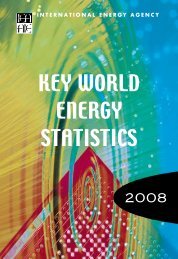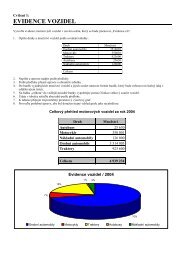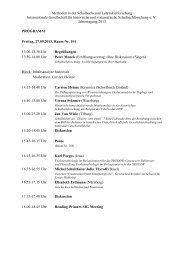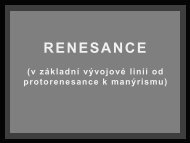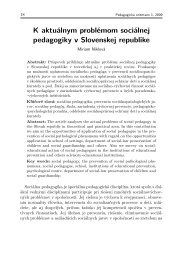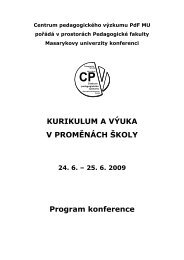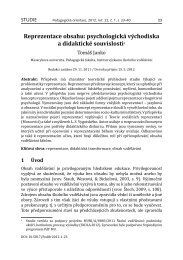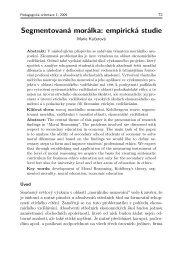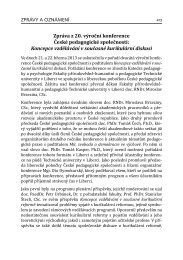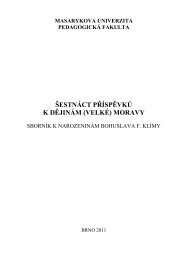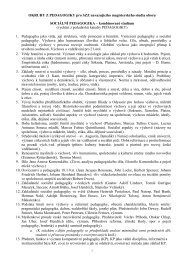Bytheway - Pedagogická fakulta MU - Masarykova univerzita
Bytheway - Pedagogická fakulta MU - Masarykova univerzita
Bytheway - Pedagogická fakulta MU - Masarykova univerzita
Create successful ePaper yourself
Turn your PDF publications into a flip-book with our unique Google optimized e-Paper software.
O INTRO<br />
Y KENNETH G. HAY<br />
DEFINING THE AESTHETIC<br />
Although consensual judgment may facilitate the differentiation<br />
of contemplative objects which are beautiful from those which<br />
are ugly, it proves more complex to defi ne the beautiful in itself.<br />
Kant gives three inter-related defi nitions of the Beautiful in<br />
the Second, Third and Fourth Moments of his Critique. In the<br />
Second, the beautiful is defi ned as: ...that which, apart from<br />
a concept, pleases universally. 5<br />
In the context of appraising fi ne art doctorates, we will use<br />
the term the aesthetic as a more acceptable, replacement for<br />
the term Beauty, within the particular dynamic of its reception<br />
by an appraising public, as discussed by Mary A. McCloskey,<br />
James O. Young, Timothy Gould and Ted Cohen.<br />
Under this aspect, for a thing (object or mode of<br />
representation) to be classifi ed as Beautiful, it must be<br />
universally accepted as such; Moreover, unlike the objects or<br />
modes of Pure Reason, which Kant dealt with in his previous<br />
Critique, it must do this without having recourse to conceptual<br />
thinking, but must instead, communicate itself to our judgment<br />
through some other kind of (pre- or non-conceptual) mechanism.<br />
Kant, here, is defending not only the right but the necessity<br />
of some (agreeable or beautiful) things (including art-objects)<br />
to appeal directly to our judgment without the mediation of<br />
discourse (verbal, logical, conceptual etc.). In this they are<br />
distinct from and outside of ethical judgments, which must still<br />
rely upon a conceptual framework.<br />
In respect of the good, it is true that judgments also<br />
rightly assert a claim to validity for every one; but the<br />
good is only represented as an Object of a universal<br />
delight by means of a concept, which is the case neither<br />
with the agreeable nor the beautiful. 6<br />
As Mary A. McCloskey observes: whereas,<br />
...with pleasure in the good, universality is thought<br />
to be based upon a concept and necessitation upon<br />
a formulable rule; with pleasure in the beautiful, despite<br />
the fact that there is a comparable universality and<br />
necessitation, there is no concept and no formulable<br />
rule. 7<br />
In other words, it seems that we cannot arrive at an objective<br />
basis for the beautiful and the agreeable in the way that we can<br />
insist upon the objective necessity of morals. Does this mean,<br />
however, that the former remain arbitrary?<br />
In the Third Moment, Kant identifi es Beauty as the Form of<br />
Finality in an object, so far as perceived in it apart from the<br />
representation of an end 8 And in the Fourth Moment, Beauty<br />
is ...that which, apart from a concept, is cognized as object of<br />
a necessary delight. 9<br />
Here, Beauty is the result of a particular organisation of<br />
constitutive elements in the object or mode of representation<br />
which attains to a quality of fi nality (end), in the sense of fi tness<br />
for purpose, which purpose is to elicit the harmonious free play<br />
of the cognitive faculties. Whether or not a given form is or is<br />
5 I. Kant, The Critique of Judgement, op.cit, Second Moment, §9, p.60.<br />
6 Ibid., §7, p. 53.<br />
7 Mary A. McCloskey, Kant’s Aesthetic. London, MacMillan Press, 19..<br />
8 I. Kant, op. cit, §17, p.80.<br />
9 Ibid., §22, p. 85.<br />
not fi nal for perception cannot be determined by the application<br />
of a concept, but can only be intuited or felt. This argument<br />
is the commonest ground of formalist (or idealist) criticism of<br />
whatever kind, and simultaneously, its fatal fl aw. 10<br />
The major attribute of the Beautiful (which Kant defi nes<br />
as the representation to the judging subject by way of the<br />
imagination) is that it is linked to the Good – it calls forth<br />
a desire in us, because desiring the Good is the categorical<br />
imperative – it is that absolute which we are driven to desire<br />
absolutely, (ie with dis-interest). We are hungry (or thirsty) for<br />
the truth. The Good, because desired by everyone, is similar or<br />
parallel to the Beautiful, except that it is based upon a concept<br />
where the Beautiful is not. How, though, can the judgment<br />
of taste attain to the quality of an absolute, if it is still based<br />
upon the particular presentation of an Object to a Subject’s<br />
perception. Its apparent universality cannot spring directly from<br />
concepts because,<br />
...from concepts, there is no transition to the feeling of<br />
pleasure or displeasure but they must instead, ...involve<br />
a claim to validity for all men, and must do so apart<br />
from universality attached to Objects i.e. there must be<br />
coupled with it a claim to subjective universality. 11<br />
The Beautiful must therefore be based upon the curious<br />
principle of subjective universality. Since, for Kant, only those<br />
judgments which are based upon a-priori categories can be<br />
objective, the judgment of the beautiful cannot be deemed<br />
objective unless there exists something resembling a concept<br />
which operates, in the case of judgments about the beautiful,<br />
as simultaneously public (extra-subjective), regulative and<br />
worthwhile in itself. For Kant this is the Form of Finality.<br />
Beauty is the Form of Finality in an object, so far as<br />
perceived in it apart from the representation of an end. 12<br />
As Wittgenstein was to argue subsequently, Kant argues<br />
that individual perceptions cannot be used as the basis of<br />
objective judgments because there is no guarantee that anyone<br />
else shares one’s own intuitions of sense-data. Sensation, then<br />
cannot be used as the defi ning principle of aesthetic judgment.<br />
For Kant, only the form (as distinct from the matter) of sensations<br />
can fulfi ll this rôle. In attempting to defi ne the characteristics of<br />
such an aesthetic form, Kant proposes two inter-related views:<br />
the form is fi nal in the sense that it is the conclusion of its<br />
potential – it has achieved a state of fi nality appropriate to its<br />
own perceptual end; and secondly, it gives rise or occasions the<br />
free play of the cognitive faculties – its end is to stimulate the<br />
faculties of imagination and understanding in an harmonious,<br />
free, play. An aesthetic form, so defi ned, is valuable in itself and<br />
does not need any further justifi cation. It exists as an absolute<br />
for the contemplation of the thinking subject and need follow no<br />
other rule than that it be fi nal for perception.<br />
What this means is that there can be no a-priori formulae<br />
whereby one form or another can be prejudged to guarantee<br />
Beauty – only in the realisation of its own fi nality for perception<br />
can an object attain this state.<br />
10 Cf K. G. Hay, Della Volpe’s Critique of Romantic Aesthetics, Parallax, Vol 1,<br />
Leeds, 1996, 0pp. 181-90.<br />
11 I. Kant, op.cit., p.51.<br />
12 Ibid., §17, p.80<br />
TEXTY_01_VESMIRY_finale.indd 7 30.3.2009 23:05:40<br />
7 P



